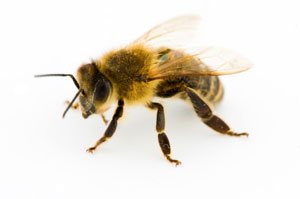Bee Venom Destroys HIV And Spares Surrounding Cells
Nanoparticles containing bee venom toxin melittin can destroy human immunodeficiency virus (HIV) while at the same time leaving surrounding cells unharmed,
The researchers said that their finding is a major step toward creating a vaginal gel that can prevent HIV spread. HIV is the virus that causes AIDS.
Melittin destroys some viruses and malignant tumor cells
Melittin is a powerful toxin found in bee venom. It can poke holes in the protective viral envelope that surrounds the human immunodeficiency virus, as well as other viruses. Free melittin in large-enough quantities can cause considerable damage.
Senior author, Samuel A. Wickline, MD, the J. Russell Hornsby Professor of Biomedical Sciences, has demonstrated that nanoparticles loaded with melittin have anti-cancer properties and have the capacity to kill tumor cells.
Normal cells remain intact - the scientists showed that nanoparticles loaded with melittin do not harm normal, healthy cells. Protective bumpers were added to the nanoparticles surface, so that when they come into contact with normal cells (which tend to be much larger), the nanoparticles bounce off rather than attach themselves.

Scientists have discovered a powerful toxin in bee venom that could end up playing a crucial role in preventing the spread of HIV.
Melittin on the nanoparticles fuses with the viral envelope. The melittin forms little pore-like attack complexes and ruptures the envelope, stripping it off the virus.
While most anti-HIV medications work on inhibiting the virus' ability to replicate, this one attacks a vital part of its structure. The problem with attacking a pathogen's ability to replicate is that it does not stop it from starting an infection. Some HIV strains have found ways to circumvent replication-inhibiting drugs, and reproduce regardless.
Melittin nanoparticles may prevent and treat existing HIV infections
Hood believes that the melittin-loaded nanoparticles have the potential for two types of therapies:
- A vaginal gel to prevent the spread of HIV infection
- Therapy for existing HIV infections, particularly drug-resistant ones
Melittin attacks double-layered membranes indiscriminately, making it a potential for drug therapies beyond HIV infections. The hepatitis B and C viruses, among several others, rely on the same type of protective envelope and could be targeted and destroyed by administering melittin-loaded nanoparticles.
The gel also has the potential to target sperm, the researchers explained, making it a possible contraceptive medication. The study, however, did not look at contraception.
This study was carried out in cells in a laboratory environment. However, the nanoparticles are easy to produce - enough of them could easily be supplied for future human studies.
it was really unknown to us.....great writing....pls refer from where have got this article.....it is indeed very much interesting
ReplyDelete